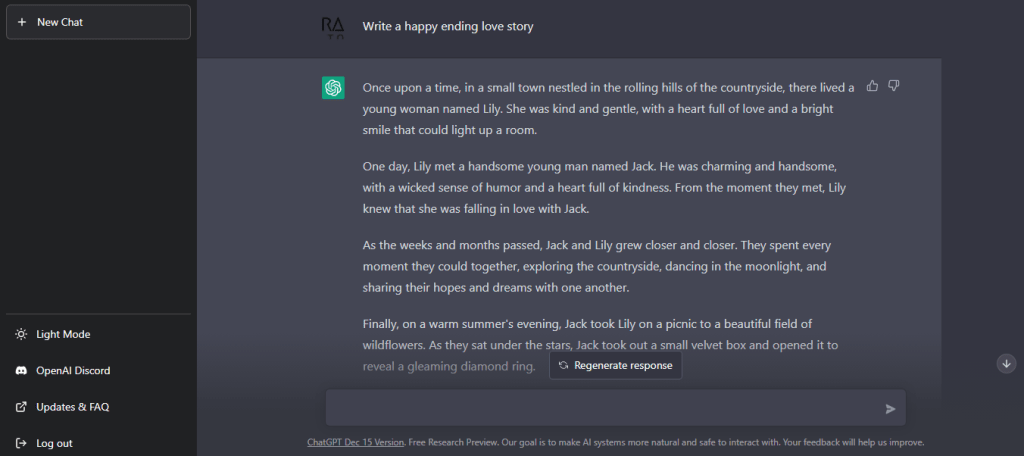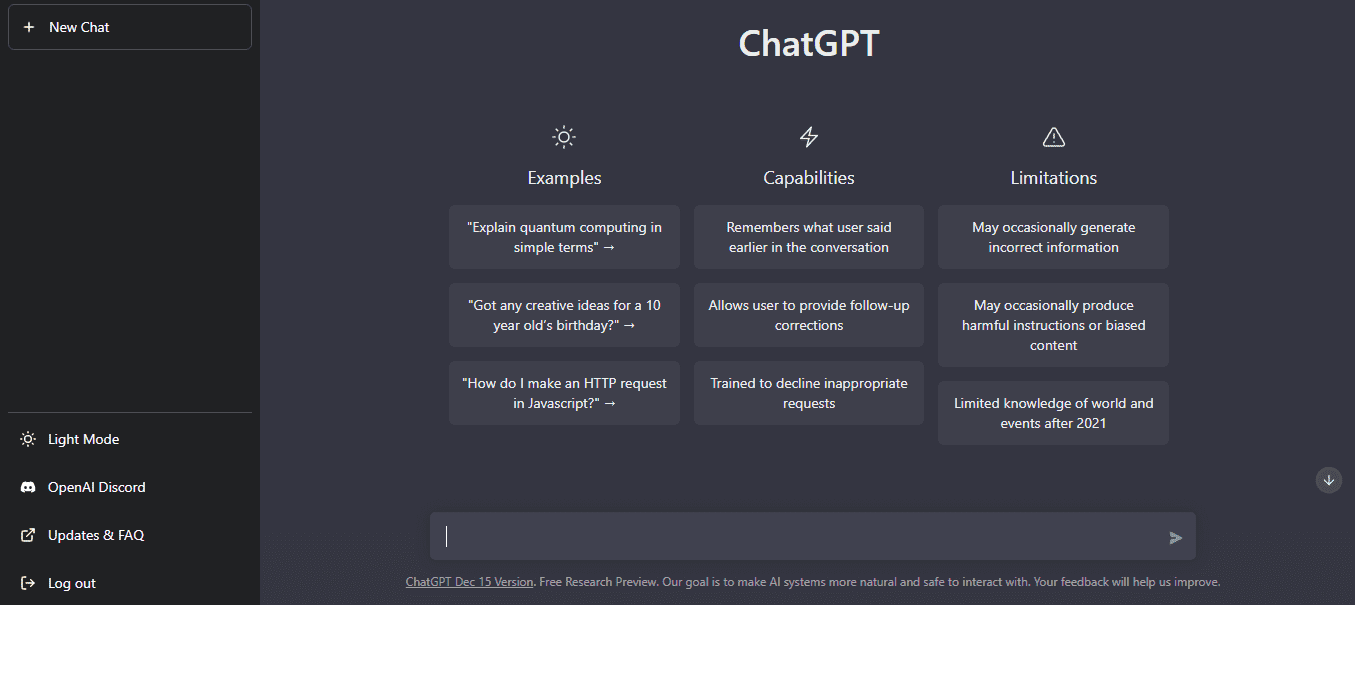ChatGPT: All you need to know
ChatGPT is an AI (Artificial Intellegience) which answer questions, provide information to questions directly without referencing or link to article of related keyword like search engine. ChatGPT can generate content in many different formats, including business idea, social media posts, videos, ads and more. It an easy to use AI, you don’t have to know how to code or have any design skills to use ChatGPT – it’s as easy as sending a message!
Table of Contents
What is ChatGPT?
An immense language model called ChatGPT by OpenAI is designed to generate human-like text in real-time, which is based on the GPT-3 (Generative Pre-trained Transformer 3) architecture, a cutting-edge machine learning model that has been trained on massive amounts of data and is capable of producing high-quality text.
If all of these sound gibberish, It is basically a tool that provide answer. You can look at it like the Advanced Google, rather than displaying result of posts, blogs, articles of related content with such keyword, it give detailed information of the question been asked. Think of anything and it would return an answer.
How to use ChatGPT?

Here is how to use ChatGPT:
1. Open up your browser and enter ChatGPT website.
2. Register if you do not have an account yet else login.
3. Type in your question into the field at the bottom of the screen and it enter.
Below is an example of a result returned by ChatGPT. In the image, I only inputted a query to “write a happy ending love story”.

This tool can also provide answers to technical questions, translate languages, write code and even debug code in various languages which is mind blowing and the list goes on.
Why use ChatGPT?
There are several reasons why ChatGPT might be used:
1. Automation: It can be used to automate tasks that involve generating text, such as customer service inquiries or data entry. This can save time and resources, and allow businesses to scale more easily.
2. Personalization: I It can be modeled and customized to give specific applications or use cases. For example, making the AI an Assumed Ethical Hacker, Dentist, etc. With this as an advantage, it can be used to create more personalized experiences for users, such as chatbots that are tailored to a specific industry or audience.
3. Creativity: With the power of ChatGPT, generating awesome responses for social media posts or writing website or blog content which makes it unique.
4. Accessibility: Multiple languages can be generated which is of good use because the AI is not only accessed by certain people but rather over the world with different languages.
Features of ChatGPT
The ability to maintain context and carry on a conversation across multiple turns is one of OpenAI ChatGPT’s main important features. This is achieved through the use of a recurrent neural network, which enables chatGPT to “remember” prior exchanges and draw on that knowledge to tailor its responses.
Below are some other key features of ChatGPT:
1. Real-time conversation: Questions asked and conversations made are been answered in real-time, allowing users to get answers instantly.
2. Maintains context: It uses a recurrent neural network to “remember” past conversations and use that information to inform its responses, allowing it to maintain context and continue a conversation over multiple turns.
3. Large data set: It is based on the GPT-3 architecture, which has been trained on a vast amount of data. This allows it to generate high-quality text that is similar to human writing.
4. Customization: It can be customized to act as who you want it to be, providing detailed and specified answers and allowing developers to create AI systems that are tailored to their needs.
5. Multiple language support: Generate responses not just in English, but in several languages if specified, making it useful for a wide range of applications.
6. Generates human-like text: It is very good at generating text that is similar to human writing, but it is not perfect and may generate responses that are nonsensical or offensive.
Potential use for ChatGPT
There are several potential use cases for ChatGPT, listed below are few:
1. Chatbots: It can be used to develop chatbots that can carry on a conversation with a user in near-real time. These chatbots could be used for customer service, sales, or other applications where automating text-based communication can save time and resources.
2. Social media: It could be used to generate responses for social media posts or to create content for social media campaigns.
3. Content creation: It could be used to write content for websites or blogs, freeing up time for human writers to focus on more creative or strategic tasks.
4. Data entry: It could be used to automate data entry tasks by generating text based on input data. Large data are required by some people/industries such as healthcare, finance, or developers which could be of good use in their application.
5. Language translation: It could be used to translate text from one language to another, allowing individual understand or businesses to communicate with a wider audience and expanding their reach.
Challenges using ChatGPT
There are a few challenges to consider when using ChatGPT:
1. Quality control: While ChatGPT is very good at generating human-like text, it is not perfect and may generate responses that are nonsensical or offensive. As we know this model is at it early stage therefore reviewing and correct the code/text generated by the model should be done to ensure that it is of high quality and meets the desired criteria.
2. Ethical considerations: The use of this tool raises ethical questions, such as issues around privacy, bias, and control. AI is not perfect therefore developers should consider these issues and use this tool in a responsible and transparent manner.
3. Customization: ChatGPT can be customized and fine-tuned for specific applications or use cases, but this requires a certain level of expertise and can be time-consuming.
4. Dependency: Relying too heavily on this AI can create a dependency on the technology, which can be problematic if the system fails or experiences an outage. It is important not to rely fully on AI as they are machines and could fail at any time.
5. Accuracy: Another challenge of using ChatGPT is ensuring that the generated text is appropriate and coherent. While the model is very good at generating human-like text, it is not perfect and may generate responses that are nonsensical or offensive therefore, It is important for users to carefully review and edit the text generated by this AI to ensure that it is of high quality and meets the desired criteria.
In short words, ChatGPT is an advanced artificial intelligence language model developed by OpenAI that has been trained on a massive amount of text data, allowing it to generate human-like language and respond to complex queries.
It can perform various tasks like answering questions, carrying out conversations, continuing on previous conversations, and providing information on a wide range of topics from natural language input such as English, Spanish, French, etc by the user.
ChatGPT is based on a transformer architecture, which enables it to handle long-range dependencies and understand contextual relationships between words and phrases which has been used in various applications such as chatbots, virtual assistants, customer service bots, and continues to evolve and improve as new data is added to its training corpus.
Thus, ChatGPT users should careful considering the challenges and ethical implications of using this technology and to use it in a responsible and transparent manner.

